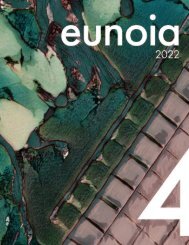WSU EUNOIA Volume III
Create successful ePaper yourself
Turn your PDF publications into a flip-book with our unique Google optimized e-Paper software.
DEVELOPING CURRICULA
FOR COMPREHENSIVE DESIGN + CONSTRUCTION
OF HIGH-PERFORMING ENERGY-EFFICIENT
RESIDENTIAL BUILDINGS IN WASHINGTON STATE
OMAR AL-HASSAWI, DON BENDER, JULIA DAY, DAVID DRAKE,
SUZANNE HAMADA, JONATHAN JONES, MAX KIRK, ABIGAIL KIRSTEN,
MIKE LUBLINER, DUSTIN MCLARTY, TAIJI MIYASAKA, MICHAEL MURPHRY,
JEFFERY NAMBA, MAGNUS NEIL, CAROLYN ROOS, GARCIA SANTANA,
RYAN SMITH, JUDY THEODORSON
FACULTY RESEARCH | FALL 2021
In
October 2021, the School of
Design + Construction was
awarded $750,000 by the
Department of Energy to develop
Curricula for Comprehensive Design and
Construction of High-Performing Energy-
Efficient Residential Buildings with focus
on the state of Washington.
No comprehensive emphasis in this
area is currently offered by colleges and
universities in the state. The VCEA’s shared
structures have not been leveraged for
interdisciplinary programs and effective
collaboration with the nationallyrecognized
WSU Extension Energy
Program has not been implemented.
Specialized courses are scattered across
different departments and schools and
typically taught at the graduate level.
Rising energy prices and energyinefficient
building stock adversely
affect households in Washington
State and nationally. Nearly one in
three Washington households are cost
burdened, spending more than 30% of
their income on housing (Phillips, 2020). 1
In Washington State, more than half of
residential buildings were built before
1980 (NEEA, 2019) 2 and residential
buildings consume 23% of all energy
(U.S. EIA, 2019; Bonlender, 2018). 3, 4
Washington has one of the most stringent
residential energy codes (WSEC-R)
nationally and is one of the most
progressive states in its commitment to
reducing greenhouse gas emissions from
buildings through its Climate Commitment
Act. However, for there to be effective
implementation by a trained workforce,
it must be coupled with accessible
education focused on energy-efficient
building design, engineering, and
construction.
For these reasons, the School of Design
+ Construction is leading an effort with
the School of Mechanical and Material
Engineering, the Department of Civil &
Environmental Engineering, and the WSU
Extension Energy Program to develop
learning modules packaged into courses
that will be grouped into three programs:
an online undergraduate certificate, an
online graduate certificate, and a hybrid
professional master’s degree.
The certificates address four competency
gaps (Energy Modeling + Simulation,
Environmental Control Systems, Envelope
Assemblies + Structural Systems, and
Building Codes, Standards, and Rating
Systems), whereas the professional
master’s addresses six gaps with the
addition of Smart Building Systems and
measured performance data.
These interdisciplinary programs are
predominantly delivered online, making
them more accessible, packaged into
short-term programs allowing for early
market entry with advanced training,
and help advance WSU’s Land Grant
Mission. The planned launch dates for
the certificates is Spring 2023 followed
by the master’s degree in Fall 2024.
REFERENCES
1 Phillips, R. (2020). To dream the
impossible dream. WSU Insider |
Washington State University. https://
news.wsu.edu/2020/07/21/dreamimpossible-dream/
2 Northwest Energy Efficiency Alliance.
(2019). RESIDENTIAL BUILDING
STOCK ASSESSMENT II Single-Family
Homes Report. https://neea.org/img/
uploads/Residential-Building-Stock-
Assessment-II-Single-Family-Homes-
Report-2016-2017.pdf
3 U.S. Energy Information Administration.
(2019). How much energy is consumed
in U.S. residential and commercial
buildings? Frequently Asked Questions.
https://www.eia.gov/tools/faqs/faq.
php?id=86
4 Bonlender, B. (2018). 2019 Biennial
Energy Report: Issues, Analysis, and
Updates. www.commerce.wa.gov/
energy
58 59
volume iii
eunoia





